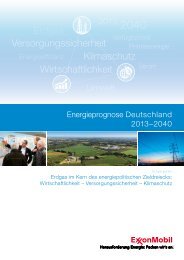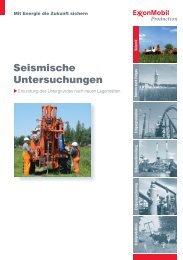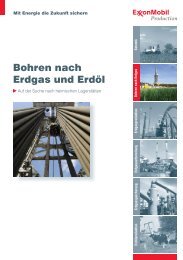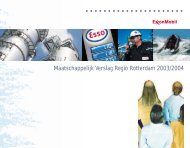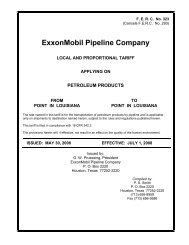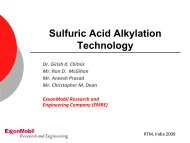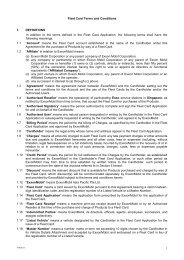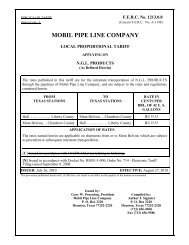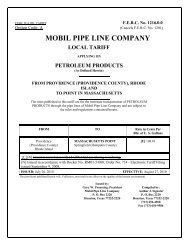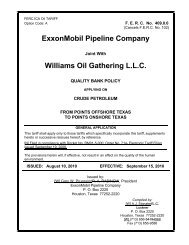Inside Papua New Guinea - ExxonMobil
Inside Papua New Guinea - ExxonMobil
Inside Papua New Guinea - ExxonMobil
Create successful ePaper yourself
Turn your PDF publications into a flip-book with our unique Google optimized e-Paper software.
A legacy of synthetic<br />
rubber innovation<br />
When the first synthetic rubber<br />
was patented in 1909, its higher<br />
cost relative to natural rubber<br />
limited its use. As auto production<br />
surged in the decades that<br />
followed, high demand for tires<br />
and inner tubes spurred interest<br />
in developing a better and less<br />
costly type of synthetic rubber.<br />
The breakthrough came in<br />
1937, when <strong>ExxonMobil</strong> scientists<br />
introduced a dynamic<br />
new rubber called butyl. This<br />
unique material was far superior<br />
to natural rubber because of its<br />
improved ability to hold air, to flex<br />
and to dampen vibration. Butyl<br />
soon became the leading rubber<br />
used in inner tubes and, years<br />
later, to hold air in tubeless tires.<br />
Today butyl rubber is practically<br />
everywhere in our lives.<br />
While its primary use remains<br />
vehicle tires and tubes, butyl is<br />
also found in inflatable sports<br />
balls, medicine-container stoppers<br />
and seals, hoses, gaskets,<br />
conveyor belts, mounts for auto<br />
engines and transmissions, tank<br />
linings, roofing materials, contact<br />
cement, sealing tapes, flooring<br />
adhesives and more.<br />
“Global demand for butyl<br />
rubber has been, and continues<br />
to be, quite strong,” says<br />
Mike Gallagher, <strong>ExxonMobil</strong><br />
Chemical’s butyl global marketing<br />
and sales manager. “We expect<br />
demand growth to average<br />
about 6 percent annually worldwide<br />
between now and 2020,<br />
31<br />
Story by Thomas L. Torget<br />
Nearly three-quarters of a century after inventing butyl rubber,<br />
<strong>ExxonMobil</strong> Chemical is a world leader in synthetic rubber<br />
technology, products and customer support.<br />
with even higher growth in the<br />
Asia-Pacific region. That growing<br />
demand makes this an excellent<br />
business to be in – a business<br />
<strong>ExxonMobil</strong> Chemical has led.”<br />
The quest for<br />
synthetic rubber<br />
As long ago as the mid-1800s,<br />
chemists began experimenting<br />
with ways to create a material<br />
that could substitute for natural<br />
rubber. During the early 1930s,<br />
the German company I.G. Farben<br />
shared with <strong>ExxonMobil</strong> its work<br />
on synthetic rubber technology.<br />
This led to development of butyl<br />
in 1937 by <strong>ExxonMobil</strong> scientists<br />
William Sparks and Robert<br />
Thomas. The two researchers’<br />
innovation was a huge breakthrough<br />
because – unlike other<br />
synthetic rubbers – butyl could<br />
be vulcanized, that is, cured with<br />
heat and sulfur to impart elasticity<br />
and other useful properties.<br />
The discovery set in motion<br />
<strong>ExxonMobil</strong>’s subsequent development<br />
of a full range of synthetic<br />
rubbers and other elastomers.<br />
The world’s first facility to<br />
produce commercial quantities<br />
of butyl was <strong>ExxonMobil</strong>’s Baton<br />
Rouge butyl plant, which began<br />
operating in 1943. Production<br />
increased two years later when<br />
the company opened a second<br />
butyl plant in Baytown, Texas.<br />
By the 1950s, <strong>ExxonMobil</strong><br />
researchers had developed<br />
technology for an all-butyl tire<br />
that provided improved traction,<br />
cornering and energy-absorbing<br />
properties. The all-butyl tire<br />
provided a smooth ride but,<br />
unfortunately, the tire wear was<br />
poor: pieces of the tire were left<br />
on the road. This era also saw<br />
development of an improved<br />
butyl known as halobutyl, which<br />
allowed covulcanizing with natural<br />
rubber and styrene-butadiene<br />
rubber. This led to <strong>ExxonMobil</strong><br />
Chemical’s introduction of two<br />
The qualities of<br />
halobutyl rubber<br />
help to retain air in<br />
tubeless radial tires.<br />
new products, chlorobutyl and,<br />
later, bromobutyl. These ongoing<br />
enhancements in butyl quality not<br />
only continued to improve the<br />
performance of tires and inner<br />
tubes, but also found application<br />
in a wide range of other industrial<br />
and consumer products.<br />
Today’s product lineup<br />
<strong>ExxonMobil</strong> Chemical’s butyl<br />
portfolio now includes three<br />
major products – Exxon butyl




